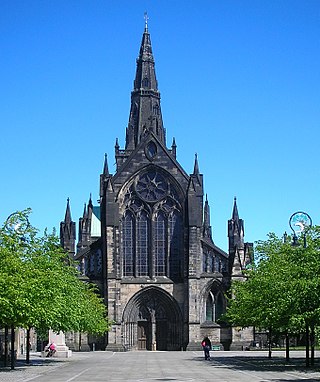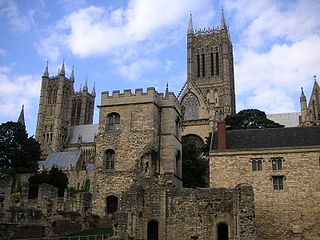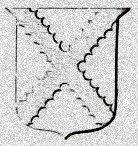Related Research Articles

Glasgow Cathedral is a parish church of the Church of Scotland in Glasgow, Scotland. It is the oldest cathedral in mainland Scotland and the oldest building in Glasgow. The cathedral was the seat of the Archbishop of Glasgow, and the mother church of the Archdiocese of Glasgow and the Province of Glasgow, until the Scottish Reformation in the 16th century. Glasgow Cathedral and St Magnus Cathedral in Orkney are the only medieval cathedrals in Scotland to have survived the Reformation virtually intact. The medieval Bishop's Castle stood to the west of the cathedral until 1789.
Ralph Neville was a medieval clergyman and politician who served as Bishop of Chichester and Lord Chancellor of England. Neville first appears in the historical record in 1207 in the service of King John, and remained in royal service throughout the rest of his life. By 1213 Neville had custody of the Great Seal of England, although he was not named chancellor, the office responsible for the seal, until 1226. He was rewarded with the bishopric of Chichester in 1222. Although he was also briefly Archbishop-elect of Canterbury and Bishop-elect of Winchester, both elections were set aside, or quashed, and he held neither office.

The Archdiocese of Glasgow was one of the thirteen dioceses of the Scottish church. It was the second largest diocese in the Kingdom of Scotland, including Clydesdale, Teviotdale, parts of Tweeddale, Liddesdale, Annandale, Nithsdale, Cunninghame, Kyle, and Strathgryfe, as well as Lennox, Carrick and the part of Galloway known as Desnes.
The Lord Chancellor of Scotland, formally the Lord High Chancellor, was a Great Officer of State in the Kingdom of Scotland.

Donnchadh was a Gall-Gaidhil prince and Scottish magnate in what is now south-western Scotland, whose career stretched from the last quarter of the 12th century until his death in 1250. His father, Gille-Brighde of Galloway, and his uncle, Uhtred of Galloway, were the two rival sons of Fergus, Prince or Lord of Galloway. As a result of Gille-Brighde's conflict with Uhtred and the Scottish monarch William the Lion, Donnchadh became a hostage of King Henry II of England. He probably remained in England for almost a decade before returning north on the death of his father. Although denied succession to all the lands of Galloway, he was granted lordship over Carrick in the north.

The Abbey of Saint Mary of Crossraguel is a ruin of a former abbey near the town of Maybole, South Ayrshire, Scotland. Although it is a ruin, visitors can still see the original monks’ church, their cloister and their dovecot.

Clan Cathcart is a Lowland Scottish clan.
Jocelin was a twelfth-century Cistercian monk and cleric who became the fourth Abbot of Melrose before becoming Bishop of Glasgow, Scotland. He was probably born in the 1130s, and in his teenage years became a monk of Melrose Abbey. He rose in the service of Abbot Waltheof, and by the time of the short abbacy of Waltheof's successor Abbot William, Jocelin had become prior. Then in 1170 Jocelin himself became abbot, a position he held for four years. Jocelin was responsible for promoting the cult of the emerging Saint Waltheof, and in this had the support of Enguerrand, Bishop of Glasgow.
Enguerrand was a twelfth-century bishop of Glasgow. He had previously been Archdeacon of Teviotdale, and had served king Máel Coluim IV as Chancellor of Scotland between 1161 and 1164. He was elected Bishop of Glasgow on Sunday, 20 September 1164, and consecrated on 28 October at the hands of Pope Alexander III himself in Sens, France, where the Pope was then resident. He did not return to the diocese until 2 June 1165. Although he resigned the position of Royal Chancellor upon election to the bishopric, there is charter evidence that he once again became Chancellor in the reign of King William the Lion, probably in the year 1171. Notable actions of his episcopate included, probably on the request of his friend Jocelin, then Abbot of Melrose, the opening of the tomb of the emerging saint Walthoef. He died on 2 February 1174.
Walter Capellanus was an important cleric and politician in the Kingdom of Scotland during the reigns of kings William the Lion and Alexander II.
The Abbot of Crossraguel was the leader of the Cluniac monastic community of Crossraguel Abbey, near Maybole in Carrick, south-west Scotland. It was founded in 1260s by Donnchadh mac Gille Brigte, earl of Carrick with monks from Paisley Abbey. Owing to the lack of surviving records and its distance from the core of Lowland Scotland in the western Gàidhealtachd, few of the abbots are known by name. The abbots were replaced by commendators in the 16th century, and the abbey came to an end when its lands were taken over by the bishops of Dunblane in 1617.
Clement was a 13th-century Dominican friar who was the first member of the Dominican Order in Britain and Ireland to become a bishop. In 1233, he was selected to lead the ailing diocese of Dunblane in Scotland, and faced a struggle to bring the bishopric of Dunblane to financial viability. This involved many negotiations with the powerful religious institutions and secular authorities which had acquired control of the revenue that would normally have been the entitlement of Clement's bishopric. The negotiations proved difficult, forcing Clement to visit the papal court in Rome. While not achieving all of his aims, Clement succeeded in saving the bishopric from relocation to Inchaffray Abbey. He also regained enough revenue to begin work on the new Dunblane Cathedral.
John de Carrick, a native of Carrick, Scotland, was a 14th-century Chancellor of Scotland and Bishop-elect of Dunkeld. Although John's exact origins are obscure, he seems to have come from a branch of the old native comital family of Carrick. Later evidence suggests he was a graduate of canon law, but the university is not known.

Hugh of Wells was a medieval Bishop of Lincoln. He began his career in the diocese of Bath, where he served two successive bishops, before joining royal service under King John of England. He served in the royal administration until 1209, when he was elected to the see, or bishopric, of Lincoln. When John was excommunicated by Pope Innocent III in November 1209, Hugh went into exile in France, where he remained until 1213.
Thomas de Dundee, also called Thomas Nicholay, was a Scottish prelate who held the bishopric of Ross during the First War of Scottish Independence. Coming from a family of Dundee burgesses, he was educated as the University of Bologna, before entering into career in the church.

Albin was a 13th-century prelate of the Kingdom of Scotland. A university graduate, Albin is known for his ecclesiastical career in the diocese of Brechin, centred on Angus in east-central Scotland.
Laurence de Ergadia was a thirteenth-century Scottish bishop. Probably from the MacDougall kindred of Argyll, Laurence had become a Dominican friar and presumably university graduate before being elected Bishop of Argyll, an election which took place sometime between 1262 and 1264. Although the election was quashed by the Pope in 1264, the Pope gave him a fresh provision to the bishopric. Laurence appears intermittently in the records during his three and a half decade episcopate, but his activities in his own diocese are badly recorded. He died as Bishop of Argyll sometime in either 1299 or 1300.
Patrick de Leuchars [also de Locrys or de Lochrys] was a 14th-century administrator and prelate in the Kingdom of Scotland. He first appears in the records in 1344 holding a church in East Lothian, and in 1351 attains national prominence as the new Bishop of Brechin. Bishop Patrick, who would be a core supporter of King David II of Scotland, became Royal Chancellor in the same decade. He held the chancellorship until around 1370, and the bishopric of Brechin until 1383, when he resigned it on account of his old age.

Nicholas de Balmyle, also called Nicholas of St Andrews, was a Scottish administrator and prelate in the late 13th century and early 14th century. A graduate of an unknown university, he served his earliest years as a clergyman at St Andrews, moving on to hold churches in Lothian as well as deputising to two archdeacons of Lothian.
Cletus from the kindred Bél was a Hungarian prelate in the first half of the 13th century, who served as Bishop of Eger from 1224 to 1245. As royal chancellor, he drafted the Golden Bull of 1222 issued by King Andrew II of Hungary.
References
- ↑ Innes, Cosmo (1837). Registrum Episcopatus Moraviensis. Bannatyne Club. p. 26.
- ↑ "Ancrum dig hoping to confirm palace site". thesouthernreporter.co.uk. Retrieved 22 September 2019.
- Dowden, John (1912). The Bishops of Scotland. Glasgow: J. Maitland Thomson. pp. 302–304. Retrieved 4 August 2019.